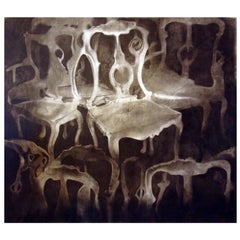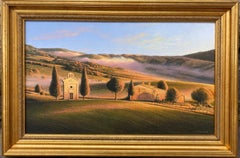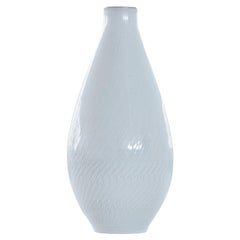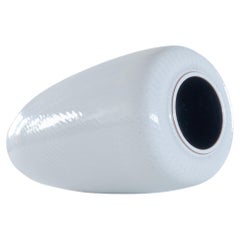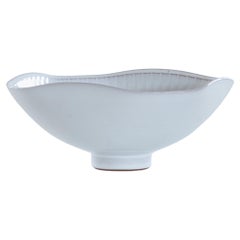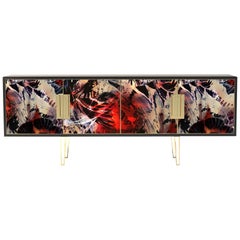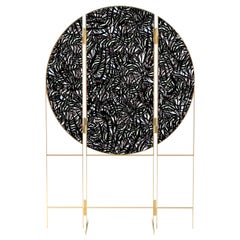Felder Felder
"Accent", Monumental Charcoal on Canvas Painting by Jessica Scott Felder
By Jessica Scott-Felder
Located in Hanover, MA
11 foot by 9 foot frame stretched charcoal on canvas painting by Jessica Scott-Felder titled
Category
Early 2000s American Modern Paintings
Materials
Canvas
$12,000
H 108 in W 132 in D 3 in
Joep Felder Set of 3 Midcentury Studio Pottery Works, 1950s
Located in Tilburg, NL
Joep Felder Set of 3 midcentury Studio Pottery pieces, The Netherlands, 1950s.
Beautiful and
Category
Mid-20th Century Dutch Mid-Century Modern Vases
Materials
Ceramic
$1,285 / set
H 9.85 in W 5.91 in D 5.91 in
Caribbean Seascape #27, original 60x42 contemporary marine landscape
By Larry Felder
Located in Spring Lake, NJ
, painting since fifteen, this artist and renaissance man, Larry Felder, earned his bachelors degree in fine
Category
21st Century and Contemporary Contemporary Landscape Paintings
Materials
Acrylic
$7,450
H 60 in W 42 in D 1 in
Serengeti Leopard, original 30x48 realist wildlife landscape
By Larry Felder
Located in Spring Lake, NJ
American renaissance man, paleontologist and realist illustrator Larry Felder patiently introduces sublime
Category
21st Century and Contemporary Realist Animal Paintings
Materials
Acrylic
$15,960
H 36 in W 54 in D 1.5 in
Chapel of the Madonna di Vitaleta, original realist Italian landscape
By Larry Felder
Located in Spring Lake, NJ
near and far. Artist and renaissance man, paleontologist and illustrator Larry Felder patiently
Category
21st Century and Contemporary Hudson River School Landscape Paintings
Materials
Oil
$2,895
H 16 in W 24 in D 1 in
Joep Felder Midcentury Studio Pottery Slender Vase with 'Wavy' Decor, 1950s
Located in Tilburg, NL
Joep Felder midcentury Studio Pottery Slender Vase with white 'wavy' decor, The Netherlands, 1950s
Category
Mid-20th Century Dutch Mid-Century Modern Vases
Materials
Ceramic
$495
H 11.82 in W 5.52 in D 5.52 in
Joep Felder Midcentury Studio Pottery Conical Vase with 'Wavy' Decor, 1950s
Located in Tilburg, NL
Joep Felder Mid Century Studio Pottery Conical Vase with white 'wavy' decor, The Netherlands, 1950s
Category
Mid-20th Century Dutch Mid-Century Modern Vases
Materials
Ceramic
$495
H 9.85 in W 5.91 in D 5.91 in
Joep Felder Mid Century Studio Pottery Bowl with 'Wavy' Decor, 1950s
Located in Tilburg, NL
Joep Felder midcentury Studio pottery bowl with white 'wavy' decor, The Netherlands, 1950s
Category
Mid-20th Century Dutch Mid-Century Modern Vases
Materials
Ceramic
$295
H 2.76 in W 5.91 in D 5.91 in
Sunrise Venezia, 35x53 original Hudson River School Italian marine landscape
By Larry Felder
Located in Spring Lake, NJ
marine landscape is tantalizing. Artist and renaissance man, paleontologist and illustrator Larry Felder
Category
21st Century and Contemporary Realist Landscape Paintings
Materials
Oil
$29,500
H 41 in W 59 in D 2 in
Recent Sales
Fine Upholstered Contemporary Side Cabinet Made in England
Located in London, GB
Covered in FELDER FELDER’S stunning Butterfly print, the Blake Sideboard combines luxurious design
Category
2010s English Modern Cabinets
Materials
Brass, Cut Steel
Fine Upholstered Contemporary Dressing Screen Made in England
Located in London, GB
Fine upholstered in FELDER FELDER’S striking Zebra butterfly print, the Pru Dressing Screen is
Category
2010s English Modern Screens and Room Dividers
Materials
Brass, Cut Steel
Fine Upholstered Contemporary Side Cabinet Made in England
Located in London, GB
Showcasing FELDER FELDER’S striking Zebra Butterfly print, the Blake Sideboard combines luxurious
Category
2010s English Modern Sideboards
Materials
Brass, Cut Steel
Fine Upholstered Contemporary Side Cabinet Made in England
Located in London, GB
Upholstered FELDER FELDER’S stunning electric blue print, the Blake sideboard combines luxurious
Category
2010s English Modern Sideboards
Materials
Brass, Cut Steel
Fine Upholstered Contemporary Cabinet Made in England
Located in London, GB
Adorned in FELDER FELDER’s captivating Yellow Leopard print, the Cordelia cabinet is a bold
Category
2010s English Modern Cabinets
Materials
Brass, Cut Steel
Fine Upholstered Contemporary Side Cabinet Made in England
Located in London, GB
Showcasing FELDER FELDER’S striking Palm print, the Blake Sideboard combines luxurious design with
Category
2010s English Modern Sideboards
Materials
Brass, Cut Steel
Fine Upholstered Contemporary Side Cabinet Made in England
Located in London, GB
Adorned in FELDER FELDER’S captivating Yellow Leopard print, the Blake Sideboard combines luxurious
Category
2010s English Modern Sideboards
Materials
Brass, Cut Steel
Fine Upholstered Contemporary Cabinet Made in England
Located in London, GB
Fine Upholstered in FELDER FELDER’s stunning electric blue print, the Cordelia cabinet is a bold
Category
2010s English Modern Cabinets
Materials
Brass, Cut Steel
Fine Upholstered Contemporary Cabinet Made in England
Located in London, GB
Showcasing FELDER FELDER’s striking Palm print, the Cordelia cabinet is a bold, confident choice
Category
2010s English Modern Cabinets
Materials
Brass, Cut Steel
Fine Upholstered Contemporary Cabinet Made in England
Located in London, GB
Fine Upholstered in FELDER FELDER’s stunning Butterfly print, the Cordelia cabinet is a bold
Category
2010s English Modern Cabinets
Materials
Brass, Cut Steel
Fine Upholstered Contemporary Cabinet Made in England
Located in London, GB
Fine Upholstered in FELDER FELDER’s striking Zebra butterfly print, the Cordelia cabinet is a bold
Category
2010s English Modern Cabinets
Materials
Brass, Cut Steel
Fine Upholstered Side Cabinet
Located in London, GB
Fine upholstered in FELDER FELDER’S striking Green Zebra Butterfly pattern, the Betty sideboard
Category
2010s English Modern Sideboards
Materials
Brass
Lafayette
By Larry Felder
Located in San Antonio, TX
Original oil on canvas inspired by opening day of oyster season and Felder's many years spent on
Category
21st Century and Contemporary Realist Landscape Paintings
Materials
Canvas, Oil
Hemingway's Canteen and Boots
By Larry Felder
Located in San Antonio, TX
took while at the Hemingway Museum in Key West, Florida. This series combines Felder's love of
Category
21st Century and Contemporary Realist Still-life Paintings
Materials
Canvas, Oil
Hemingway at Finca Vigia
By Larry Felder
Located in San Antonio, TX
artist took while at the Hemingway Museum in Key West, Florida.
Larry Felder was born in San Antonio
Category
2010s Realist Interior Paintings
Materials
Canvas, Oil
Mallards at Brackenridge Park
By Larry Felder
Located in San Antonio, TX
Larry Felder was born in San Antonio, Texas. In 1974, he earned a BFA in Studio Painting from The
Category
2010s Contemporary Animal Paintings
Materials
Oil
Edgar Allen Poe
By Larry Felder
Located in San Antonio, TX
Larry Felder was born in San Antonio, Texas. In 1974, he earned a BFA in Studio Painting from The
Category
2010s Contemporary Portrait Paintings
Materials
Oil
Kurt Vonnegut
By Larry Felder
Located in San Antonio, TX
Larry Felder was born in San Antonio, Texas. In 1974, he earned a BFA in Studio Painting from The
Category
2010s Contemporary Portrait Paintings
Materials
Oil
Truman Capote
By Larry Felder
Located in San Antonio, TX
Larry Felder was born in San Antonio, Texas. In 1974, he earned a BFA in Studio Painting from The
Category
2010s Contemporary Portrait Paintings
Materials
Oil
Hermann Hesse
By Larry Felder
Located in San Antonio, TX
Larry Felder was born in San Antonio, Texas. In 1974, he earned a BFA in Studio Painting from The
Category
2010s Contemporary Portrait Paintings
Materials
Oil
John Steinbeck
By Larry Felder
Located in San Antonio, TX
Larry Felder was born in San Antonio, Texas. In 1974, he earned a BFA in Studio Painting from The
Category
2010s Contemporary Portrait Paintings
Materials
Oil
Aldous Huxley
By Larry Felder
Located in San Antonio, TX
Larry Felder was born in San Antonio, Texas. In 1974, he earned a BFA in Studio Painting from The
Category
2010s Contemporary Portrait Paintings
Materials
Oil
George Orwell
By Larry Felder
Located in San Antonio, TX
Larry Felder was born in San Antonio, Texas. In 1974, he earned a BFA in Studio Painting from The
Category
2010s Contemporary Portrait Paintings
Materials
Oil
French Coutyard
By Larry Felder
Located in San Antonio, TX
color. Original photographer and publisher in France unknown.
Larry Felder was born in San Antonio
Category
2010s Impressionist Landscape Paintings
Materials
Canvas, Oil
French Countryside
By Larry Felder
Located in San Antonio, TX
color. Original photographer and publisher in France unknown.
Larry Felder was born in San Antonio
Category
2010s Impressionist Landscape Paintings
Materials
Canvas, Oil
Herding Sheep
By Larry Felder
Located in San Antonio, TX
color. Original photographer and publisher in France unknown.
Larry Felder was born in San Antonio
Category
2010s Impressionist Landscape Paintings
Materials
Canvas, Oil
Blue Hole Reflections
By Larry Felder
Located in San Antonio, TX
stretcher bars and heavy duty canvas.
Larry Felder was born in San Antonio, Texas. In 1974, he earned a BFA
Category
2010s Contemporary Landscape Paintings
Materials
Oil
Japanese Tea Gardens
By Larry Felder
Located in San Antonio, TX
made stretcher bars and heavy duty canvas.
Larry Felder was born in San Antonio, Texas. In 1974, he
Category
2010s Contemporary Landscape Paintings
Materials
Oil
San Pedro Springs
By Larry Felder
Located in San Antonio, TX
stretcher bars and heavy duty canvas.
Larry Felder was born in San Antonio, Texas. In 1974, he earned a BFA
Category
2010s Contemporary Landscape Paintings
Materials
Oil
Rookery
By Larry Felder
Located in San Antonio, TX
Larry Felder is inspired by his years spent on the Gulf Coast of Texas and Florida. In this
Category
21st Century and Contemporary Realist Animal Paintings
Materials
Canvas, Oil
American White Pelican
By Larry Felder
Located in San Antonio, TX
Painting will ship unframed.
Larry Felder is inspired by his years spent on the Gulf Coast of
Category
2010s Realist Animal Paintings
Hemingway's Arturo Fuente Signature Cigars
By Larry Felder
Located in San Antonio, TX
took while at the Hemingway Museum in Key West, Florida.
The painting combines Felder's love of
Category
2010s Realist Still-life Paintings
Materials
Canvas, Oil
Hemingway’s Reel and Helmet
By Larry Felder
Located in San Antonio, TX
took while at the Hemingway Museum in Key West, Florida.
The painting combines Felder's love of
Category
2010s Realist Still-life Paintings
Materials
Canvas, Oil
Good Morning Cortez
By Larry Felder
Located in San Antonio, TX
Larry Felder is inspired by his years spent on the Gulf Coast of Texas and Florida. This painting
Category
2010s Realist Landscape Paintings
Materials
Canvas, Oil
Serendipity Whippo
By Larry Felder
Located in San Antonio, TX
Felder was born in San Antonio, Texas on September 30, 1948. He spent his childhood living in San Antonio
Category
2010s Contemporary Portrait Paintings
Materials
Canvas, Oil
Off Felder Creek
By Kristen Garneau
Located in Mill Valley, CA
oil on canvas over panel
Category
2010s Contemporary Landscape Paintings
Materials
Canvas, Oil, Panel
Original Vintage Montreux Oberland Bernois MOB Railway Poster Featuring a Golfer
By Klaus Felder
Located in London, GB
Klaus Felder SA Vevey, Switzerland. Good condition, minor repaired tears on margins.
Category
Vintage 1960s Swiss Posters
Materials
Paper
H 40.16 in W 25.2 in D 0.04 in
Gianvito Rossi Black Suede Felder Flat Cuissard Over the Knee Boots Size 40
By Gianvito Rossi
Located in Dubai, Al Qouz 2
Perfect for the winter season, these Gianvito Rossi Felder Flat Cuissard over-the-knee boots are
Category
2010s Italian Boots
Joep Felder Midcentury Studio Pottery Vase, 1950s
Located in Tilburg, NL
Joep Felder midcentury Studio pottery vase, The Netherlands, 1950s.
Beautiful and rare
Category
Mid-20th Century Mid-Century Modern Vases
Materials
Stoneware
Lazy Morning, original 30x48 realist figurative leopard landscape
By Larry Felder
Located in Spring Lake, NJ
Felder has detailed the tiger's coat down to the root of each hair such that the patterns created across
Category
21st Century and Contemporary Realist Figurative Paintings
Materials
Oil
Original Vintage Montreux Oberland Bernois MOB Railway Poster Featuring A Golfer
By Klaus Felder
Located in London, GB
Klaus Felder SA Vevey, Switzerland. Good condition, minor repaired tears on margins.
Category
1960s More Prints
Materials
Paper
Old Coast Guard Station
By Larry Felder
Located in San Antonio, TX
Larry Felder was born in San Antonio, Texas on September 30, 1948. He spent his childhood living in
Category
Early 2000s Impressionist Landscape Paintings
Materials
Canvas, Oil
Iron and Wicker Basket
By Steve Davis
Located in San Antonio, TX
of his studio in the coastal town of Port Aransas, Texas and is represented by Felder Gallery.
Category
21st Century and Contemporary Contemporary Mixed Media
Materials
Mixed Media
Fine Upholstered Contemporary Dressing Screen Made in England
Located in London, GB
Fine upholstered in FELDER FELDER’S stunning Butterfly print, the Queenie dressing screen is
Category
2010s English Modern Screens and Room Dividers
Materials
Brass, Cut Steel
Hemingway’s Passport
By Larry Felder
Located in San Antonio, TX
series combines Felder's love of reflections and his appreciation for Hemingway's writing and lifestyle
Category
2010s Realist Still-life Paintings
Materials
Canvas, Oil
A Farewell to Arms
By Larry Felder
Located in San Antonio, TX
This painting by Larry Felder is created from sketches and photos the artist took looking inside
Category
21st Century and Contemporary Realist Still-life Paintings
Materials
Canvas, Oil
French Dog and Boat
By Larry Felder
Located in San Antonio, TX
color. Original photographer and publisher in France unknown.
Larry Felder was born in San Antonio
Category
2010s Impressionist Landscape Paintings
Materials
Canvas, Oil
Palms
By Larry Felder
Located in San Antonio, TX
Larry Felder's painting of a palm tree with coconuts was created in 2012 while living in Central
Category
21st Century and Contemporary Contemporary Abstract Paintings
Materials
Canvas, Oil
Get Updated with New Arrivals
Save "Felder Felder", and we’ll notify you when there are new listings in this category.
Felder Felder For Sale on 1stDibs
On 1stDibs, you can find the most appropriate felder felder for your needs in our varied inventory. There are many Contemporary and Impressionist versions of these works for sale. Finding the perfect felder felder may mean sifting through those created during different time periods — you can find an early version that dates to the 20th Century and a newer variation that were made as recently as the 21st Century. If you’re looking to add a felder felder to create new energy in an otherwise neutral space in your home, you can find a work on 1stDibs that features elements of gray, black, brown and more. Finding an appealing felder felder — no matter the origin — is easy, but Larry Felder, Bill Green, Klaus Felder and Kristen Garneau each produced popular versions that are worth a look. Artworks like these of any era or style can make for thoughtful decor in any space, but a selection from our variety of those made in oil paint, paint and canvas can add an especially memorable touch.
How Much is a Felder Felder?
The price for an artwork of this kind can differ depending upon size, time period and other attributes — a felder felder in our inventory may begin at $345 and can go as high as $12,000, while the average can fetch as much as $3,500.
